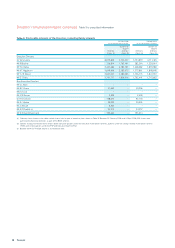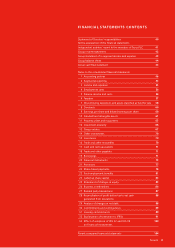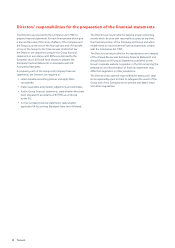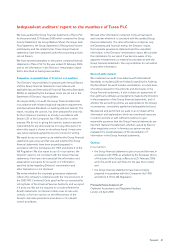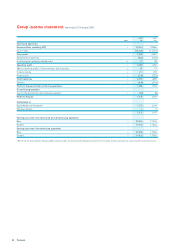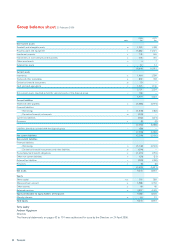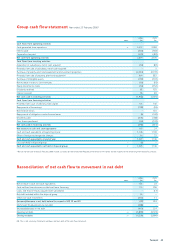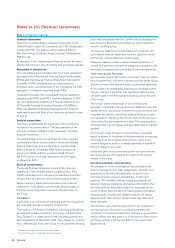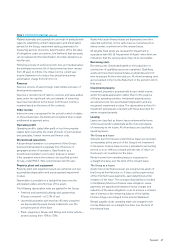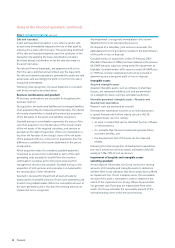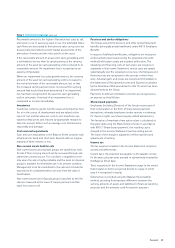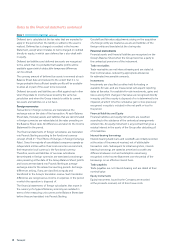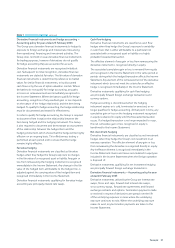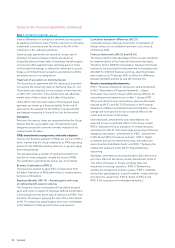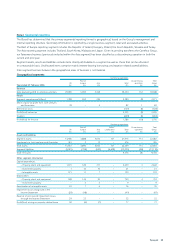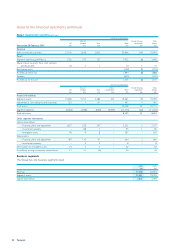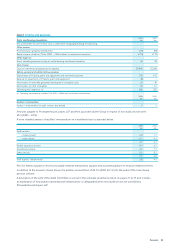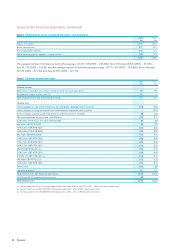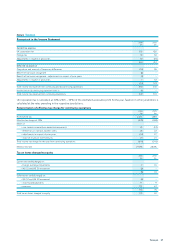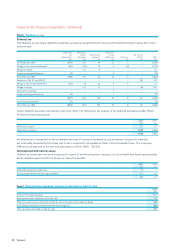Tesco 2006 Annual Report Download - page 50
Download and view the complete annual report
Please find page 50 of the 2006 Tesco annual report below. You can navigate through the pages in the report by either clicking on the pages listed below, or by using the keyword search tool below to find specific information within the annual report.
48 Tesco plc
Notes to the financial statements continued
Note 1 Accounting policies continued
Sale and leaseback
Asale and leaseback transaction is one where a vendor sells
an asset and immediately reacquires the use of that asset by
entering into a lease with the buyer. The accounting treatment
of the sale and leaseback depends upon the substance of the
transaction (by applying the lease classification principles
described above) and whether or not the sale was made at
the asset’s fair value.
For sale and finance leasebacks, any apparent profit or loss
from the sale is deferred and amortised over the lease term.
For sale and operating leasebacks, generally the assets are sold
at fair value, and accordingly the profit or loss from the sale is
recognised immediately.
Following initial recognition, the lease treatment is consistent
with those principles described above.
Business combinations and goodwill
All business combinations are accounted for by applying the
purchase method.
On acquisition, the assets and liabilities and contingent liabilities
of an acquired entity are measured at their fair value. The interest
of minority shareholders is stated at the minority’s proportion
of the fair values of the assets and liabilities recognised.
Goodwill arising on consolidation represents the excess of the
costof an acquisition over the fair value of the Group’s share
of the net assets of the acquired subsidiary, joint venture or
associate at the date of acquisition. If the cost of acquisition is
lessthan the fair value of the Group’s share of the net assets
of the acquired entity (i.e. a discount on acquisition) then the
difference is credited to the Income Statement in the period
of acquisition.
At the acquisition date of a subsidiary, goodwill acquired is
recognised as an asset and is allocated to each of the cash-
generating units expected tobenefit from the business
combination’s synergies and to the lowest level at which
management monitorsthe goodwill. Goodwill arising on the
acquisition of joint ventures and associates is included within
the carrying value of the investment.
Goodwill is reviewed for impairment at least annually by
assessing the recoverable amount of each cash-generating unit
towhich the goodwill relates. When the recoverable amount of
the cash-generating unit is lessthan the carrying amount, an
impairment loss is recognised.
Any impairment is recognised immediately in the Income
Statement and is not subsequently reversed.
On disposal of a subsidiary, joint venture or associate, the
attributable amount of goodwill is included in the determination
of the profit or loss on disposal.
Goodwill arising on acquisitions before 29 February 2004
(the date of transition to IFRSs) has been retained at the previous
UK GAAP amounts subject to being tested for impairment at
that date. Goodwill written off to reserves under UK GAAP prior
to1998 has not been restated and will not be included in
determining any subsequent profit or loss on disposal.
Intangible assets
Acquired intangible assets
Acquired intangible assets, such as software or pharmacy
licences, are measured initially at cost and are amortised
on a straight-line basis over their estimated useful lives.
Internally-generated intangible assets – Research and
development expenditure
Research costs are expensed as incurred.
Development expenditure incurred on an individual project
is carried forward only if all the criteria set out in IAS 38
‘Intangible Assets’ are met, namely:
• an asset is created that can be identified (such as software
or new processes);
• it is probable that the asset created will generate future
economic benefits; and
• the development cost of the asset can be measured
reliably.
Following the initial recognition of development expenditure,
the costis amortised over the project’s estimated useful life,
usually at 14%-25% of cost per annum.
Impairment of tangible and intangible assets
excluding goodwill
At each BalanceSheet date, the Group reviews the carrying
amounts of its tangible and intangible assets todetermine
whether there is any indication that those assets have suffered
an impairment loss. If such indication exists, the recoverable
amount of the asset is estimated in order to determine the
extent of the impairment loss (if any). Where the asset does
notgenerate cash flows that are independent from other
assets, the Group estimates the recoverable amount of the
cash-generating unit to which the asset belongs.


